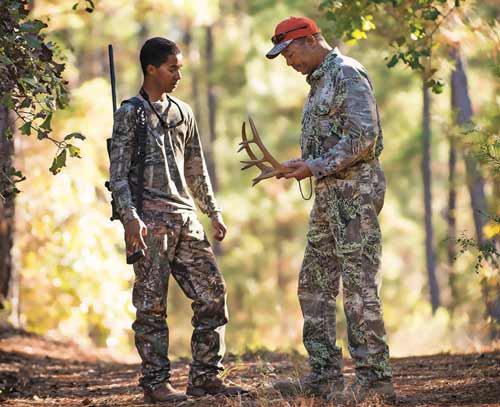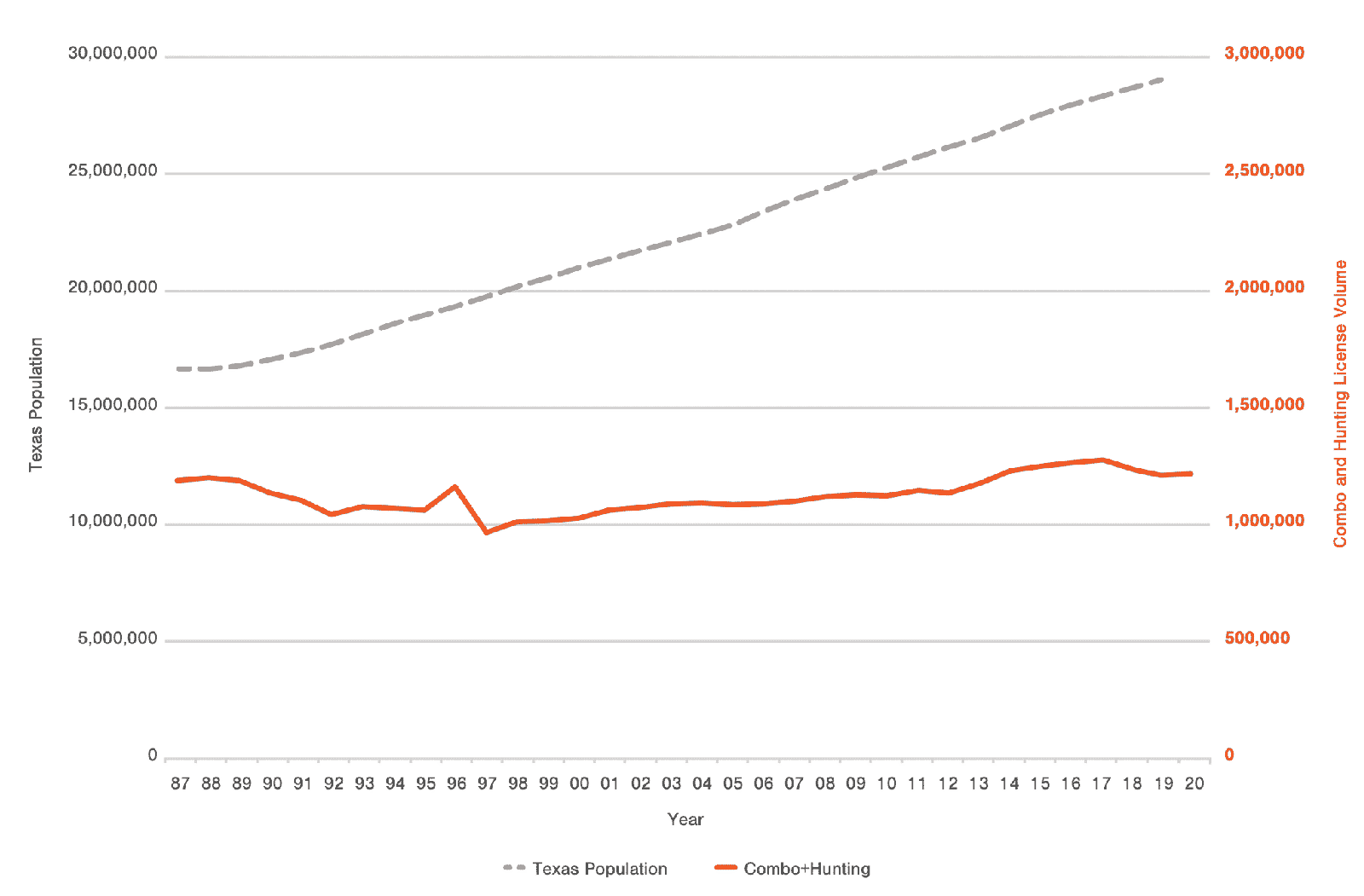Texas R3 Hunting Goals
Table of Contents
Skip to Goals
Texas had enjoyed an average annual growth of approximately 1.5% in hunting license sales for the 10 years prior to 2017 when Hurricane Harvey hit the Texas Gulf Coast in mid-August. The devastating effects of the storm negatively affected license sales for the season, and the 2018-2019 numbers show another slight dip (M. Hobson, personal communication). Despite the last two years of decline, Texas continues to hold steady over the long-term with over 1.2 million hunters. However, when compared with the rapid population growth in Texas, the gap between the number of Texans and the number of Texan hunters grows larger each year (Figure 4).

Churn is a nationally accepted term describing when a license buyer purchases a license one year but does not purchase the following year. Inconsistencies in license purchasing behavior (i.e., churn) make it difficult for game-and-fish agencies, which depend heavily on license sales revenue, to fund their conservation efforts and or budget for future operations. Texas hunting license buyers, much like those in other states, are sporadic in their license buying behavior and churn at a rate of about 30% annually. To lower this number, TPWD will need to develop retention strategies that make it easier for hunters to consistently buy a license. Examples of these types of strategies would be implementing an automatic license renewal system or, at a minimum, sending timely renewal reminder emails.
Although research is extremely limited on the subject, national R3 experts have begun shifting focus from mentored hunting and fishing programs for youth, where it has historically been placed in most states, to adults for a variety of reasons (Responsive Management/National Shooting Sports Foundation, 2017). Shifting focus to adult mentoring capitalizes on the adult’s ability to influence the rest of their family (including their children) and provide the resources needed to continue hunting (transportation, money, etc.). Adult hunt mentoring programs also attract the increasing number of adults with a keen interest in acquiring their own food from a local source. In addition, these adult opportunities lend themselves to an audience of non-traditional hunters where the common criticism of youth hunting programs has always been that they target (intentionally or not) a demographic of kids that would have likely hunted anyway.
“Generations of parents have passed on to their children a passion and respect for nature, an understanding of where food and water really come from, and the lessons of patience and perseverance. Few activities teach as much about the daily rhythms of nature as effectively as hunting and fishing.”
— TPWD Land and Water Resources Conservation and Recreation Plan
Texas, like most states, has historically focused on youth hunting as a key recruitment and retention activity. While TPWD and many partners continue to embrace this idea, the department piloted a Mentored Hunting Program in 2008 to offer hands-on educational opportunities for adults with no hunting background but an appetite to learn more about all aspects of the activity. This program has slowly expanded over the last decade, averaging about seven hunts per season before increasing to 20 hunts in the 2019-2020 season. For the past two years, over 70% of mentored hunt participants have bought a hunting license for the following season. While pleased with these numbers, TPWD understands this is a snapshot in time and it must continue to make sure resources are used wisely by ensuring only new hunters are registered for these hunts. With the increased focus on these adult mentored opportunities nationally, many state partners have begun offering their own adult mentored hunts which is extremely encouraging. Coordination of efforts to include consistent mentor training and program messaging statewide should expand the availability of these important programs and produce meaningful results.
Figure 4: Texas combo and hunting license sales compared to Texas population, 1987-2020.

Note: In 2020, hunting license sales increased by 8% versus previous year. A large part of this increase can be attributed to the COVID-19 pandemic, which has given people more time and inclination to social distance and relieve stress by getting outside. With so many other activity options being limited, or unavailable, people have turned to hunting, fishing, boating, parks and other outdoor activities.
Outline of Hunting Goals
- Goal 1: Increase hunting license sales at least 1% annually
- Objective: Decrease hunting license churn rates by 1% annually
Metric: Retention of current combination and hunting license buyers
Target Audience: License buyers with a focus on first-time buyers and other high-value segments
Timeframe: Short-term, Ongoing- Incorporate features like auto-renewal and renewal reminder emails
- Communicate with first-time license buyers about access and social support opportunities (e.g., public hunting program, Texas Big Game Awards)
- Communicate with lapsed hunters about new opportunities
- Objective: Maintain and increase access to public hunting land
Metric: Number of acres in the program
Target Audience: TPWD and partners
Timeframe: Short-term, Ongoing
- Identify public lands not currently being hunted and work with agencies to expand access
- Incentivize public use on private lands (financial, exotic control, etc.)
- Reduce liability concerns for private landowners providing public access for hunting when possible
- Continue to apply for and provide third-party grant funding (e.g., USDA Voluntary Public Access and Habitat Incentive Program) for public access projects
- Use spatial technologies (GIS software, census data and other demographic databases) to focus access opportunities near major population centers
- Objective: Decrease hunting license churn rates by 1% annually
- Goal 2: Engage new hunters
- Objective: Recruit new hunters
Metric: License sales data
Target Audience: TPWD and partners
Timeframe: Ongoing
- Evaluate existing programs to include using tapestry data to determine diversity of participants (see Cross-Program Goal 1)
- Continue implementing hunter recruitment programs that are successfully introducing people to hunting experiences
- Continue to monitor post-event license buying behaviors of Becoming an Outdoors-Woman (BOW) participants
- Develop ways to communicate with participants of the Community Archery Program after the event to share information regarding mentored opportunities
- Monitor post-event license buying behavior of those who participate in game warden outreach events
- Monitor post-event license buying behavior of those who participate in Hunting 101 classes
- Increase efforts to connect National Archery in the Schools Program (NASP) participants with Hunter Education and recruitment programs, since archery is a gateway activity to other hunting opportunities
- Develop ways to communicate with participants after locavore events to share information regarding mentored opportunities
- Monitor post-event license-buying behavior after mentored hunting workshops
- Ensure that partners (Texas Youth Hunting Program, TWA/Stewards of the Wild Adult Mentored Hunts, Texas Brigades, JAKES Days, Wheelin’ Sportsmen, etc.) collect customer numbers during recruitment activities so that post-event license buying behavior can be monitored
- Objective: Expand adult mentored hunting opportunities
Metric: License sales of those who participate in mentored hunts
Target Audience: Adults with an interest in hunting but no hunting experience
Timeframe: Short-term, Ongoing
- Host mentored hunting workshops on additional state parks and WMAs annually
- Work with conservation partners to coordinate efforts in expanding adult mentored hunting opportunities and evaluating results
- Support partners in training mentors, conducting hunts, and encouraging established hunters to mentor new hunters on their own
- Objective: Simplify license-buying process and products
Metric: Survey license buyers for satisfaction
Target Audience: New, current and lapsed hunters
Timeframe: Short-term, Long-term, Ongoing
- Implement a more convenient license and tag system
- Develop and implement strategic plan to move toward a modern and simplified license and tagging system
- Continue to develop and send license renewal emails with an increased focus on first-time license buyers
- Develop and implement an auto-renewal license option
- Reduce and/or introduce more appealing/relevant license types per the 2016 fee analysis
- Implement a more convenient license and tag system
- Objective: Expand locavore program
Metric: License sales and program participants
Target Audience: Foodies, millennials
Timeframe: Short-term, Ongoing
- Communicate with and track participants in their interaction with TPWD after attending a wild game cooking event
- Expand current wild game cooking classes (e.g., Central Market) to include additional opportunities, including outings for the chefs/instructors
- Expand online content dealing with wild game cooking
- Incorporate wild game cooking into multiple hunting recruitment activities
- Objective: Recruit new hunters